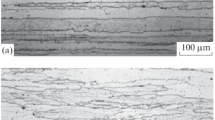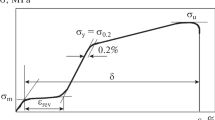Abstract
We have carried out complex studies of the structure and properties after thermal hardening by the T1 mode of pressed shapes 20–40 mm thick from a new promising high aluminum alloy V-1977 based on the Al–Zn–Mg–Cu system with the addition of Zr. It has been found that, after aging according to the T1 mode, in the pressed shapes of alloy V-1977, a homogeneous structure and a uniform distribution of finely dispersed nanocrystalline particles of the η' phase and dispersoids of the β' phase (ZrAl3) with spherical shape are observed. Owing to this, the required level of mechanical, corrosion, and resource characteristics for parts of modern aviation and missile technology is achieved. Thus, the V-1977 alloy is shown to be competitive in comparison with the widespread serial alloy V95och and a domestic analog of alloy V96ts-3pch.


Similar content being viewed by others
REFERENCES
Kablov, E.N., Innovations of VIAM as part of implementing the Strategic Directions of Development of Materials and Technologies of Their Processing for the Period up to 2030, Aviats. Mater. Tekhnol., 2015, no. 1 (34), pp. 3–33. https://doi.org/10.18577/2071-9140-2015-0-1-3-33
Fridlyander, I.N., Senatorova, O.G., and Tkachenko, E.A., High-strength alloys of Al–Zn–Mg–Cu system, in Mashinostroenie. Entsiklopediya. T. II-3: Tsvetnye metally i splavy. Kompozitsionnye metallicheskiye materialy (Mechanical Engineering. Encyclopedia. Vol. II-3: Non-Ferrous Metals and Alloys. Composite Metal Materials), Moscow: Mashinostroenie, 2001, pp. 94–128.
Fridlyander, I.N., Senatorova, O.G., Tkachenko, E.A., and Molostova, I.I., Development and application of high-strength alloys of the Al–Zn–Mg–Cu system in aerospace engineering, in 75 let. Aviatsionnye materialy (75th Anniversary. Aviation Materials), Moscow: VIAM, 2007, pp. 155–163.
Antipov, V.V., Strategies of developing titanium, magnesium, beryllium and aluminum alloys, Aviats. Mater. Tekhnol., 2012, no. S, pp. 157–167.
Fridlyander, I.N., High-strength aluminum alloys with zinc, magnesium, and copper, Met. Sci. Heat Treat., 2003, vol. 45, nos. 9–10, pp. 341–343. https://doi.org/10.1023/B:MSAT.0000009777.50737.71
Fridlyander, I.N., Aluminum alloys in aircraft during the period from 1970 to 2015, Technol. Legk. Splavov, 2002, no. 4, pp. 12–17.
Kablov, E.N., Aerospace materials science, Vse Mater. Entsikl. Sprav., 2008, no. 3, pp. 2–14.
Antipov, V.V., Senatorova, O.G., Tkachenko, E.A., and Vakhromov, R.O., Aluminium wrought alloys, Aviats. Mater. Tekhnol., 2012, no. S, pp. 167–182.
Kosarina, E.I., Generalov, A.S., and Demidov, A.A., Questions of X-ray non-destructive testing in Russian state standardization system, Tr. Vseross. Inst. Aviats. Mater., 2018, no. 11 (71), pp. 86–92. https://doi.org/10.18577/2307-6046-2018-0-11-86-92. http://www.viam-works.ru (Accessed December 18, 2019).
Warner, T., Recently-developed aluminium solutions for aerospace applications, Mater. Sci. Forum, 2006, vols. 519–521, pp. 1271–1278. https://doi.org/10.4028/www.scientific.net/MSF.519-521.1271
Denzer, D., Rioja, R., Bray, G., Venema, G., and Colvin, E., The evolution of plate and extruded products with high strength and fracture toughness, Proc. 13th Int. Conf. on Aluminum Alloys (ICAA-13), Pittsburgh, PA, June 3–7, 2012, pp. 587–593.
Smith, B., The Boeing-777, Adv. Mater. Processes, 2003, vol. 161, no. 9, pp. 41–44.
Polmear, I.J., Control of precipitation processes and properties in aged aluminium alloy by traced element additions, Proc. 6th Int. Conf. on Aluminum Alloys (ICAA-6), Tokyo, Japan, July 5–10, 1998, vol. 1, pp. 75–86.
Kablov, E.N., Strategic areas of developing materials and their processing technologies for the period up to 2030, Aviats. Mater. Tekhnol., 2012, no. S, pp. 7–17.
Fridlyander, I.N., Alyuminievye deformiruemye konstruktsionnye splavy (Aluminum Deformable Structural Alloys), Moscow: Metallurgiya, 1979, pp. 160–163.
Kablov, E.N., All-Russian Institute of aviation materials–80 years old, Deform. Razrush. Mater., 2012, no. 6, pp. 17–19.
Selivanov, A.A., Tkachenko, E.A., Popova, O.I., and Babanov, V.V., High-strength wrought aluminum weldable V-1963 alloy for details of primary structure of modern aviation engineering, Tr. Vseross. Inst. Aviats. Mater., 2017, no. 2(50), pp. 3–10. https://doi.org/10.18577/2307-6046-2017-0-2-1-1. http://www.viam-works.ru (Accessed December 24, 2019).
Kurs, M.G., Kutyrev, A.E., and Fomina, M.A., Research of corrosion damage of wrought aluminium alloys at laboratory and full-scale tests, Tr. Vseross. Inst. Aviats. Mater., 2016, no. 8(44), pp. 72–82. https://doi.org/10.18577/2307-6046-2016-0-8-10-10. http://www.viam-works.ru (Accessed January 10, 2020).
Pavlovskaya, T.G., Deshevaya, E.A., Zaitsev, S.N., Kozlov, I.A., Volkov, I.A., and Zakharov, K.E., Corrosion resistance of aluminum alloys in conditions simulating space flight, Tr. Vseross. Inst. Aviats. Mater., 2016, no. 3(39), pp. 85–93. https://doi.org/10.18577/2307-6046-2016-0-3-11-11. http://www.viam-works.ru (Accessed January 10, 2020).
Solov’ev, A.E., Golynets, S.A., Khvatskii, K.K., and Aslanyan, I.R., Performing of static tensile tests on Zwick/Roell machines, Tr. Vseross. Inst. Aviats. Mater., 2015, no. 8, art. 12. https://doi.org/10.18577/2307-6046-2015-0-8-12-12. http://www.viam-works.ru (Accessed December 12, 2019).
Beletskii, V.M. and Krivov, G.A., Alyuminievye splavy (sostav, svoistva, tekhnologiya, primenenie): Spravochnik (Aluminum Alloys (Composition, Properties, Technology, Application): Handbook), Fridlyanler, I.N., Ed., Kiev: Komintekh, 2005, pp. 99–100.
ACKNOWLEDGMENTS
This work was carried out as part of the comprehensive scientific direction “High-Strength Weldable Aluminum and Aluminum-Lithium Alloys of Low Density with Increased Fracture Toughness” (“Strategic Directions for the Development of Materials and Processing Technologies for the Period up to 2030”).
Author information
Authors and Affiliations
Corresponding author
Additional information
Translated by G. Dedkov
Rights and permissions
About this article
Cite this article
Nechaikina, T.A., Somov, A.V., Ivanov, A.L. et al. Investigation of the Thermal Hardening Impact by the T1 Mode on the Structure and Properties of Pressed Shapes from a Promising Super-Strength Alloy of the Al–Zn–Mg–Cu System. Inorg. Mater. Appl. Res. 12, 909–914 (2021). https://doi.org/10.1134/S2075113321040304
Received:
Revised:
Accepted:
Published:
Issue Date:
DOI: https://doi.org/10.1134/S2075113321040304




